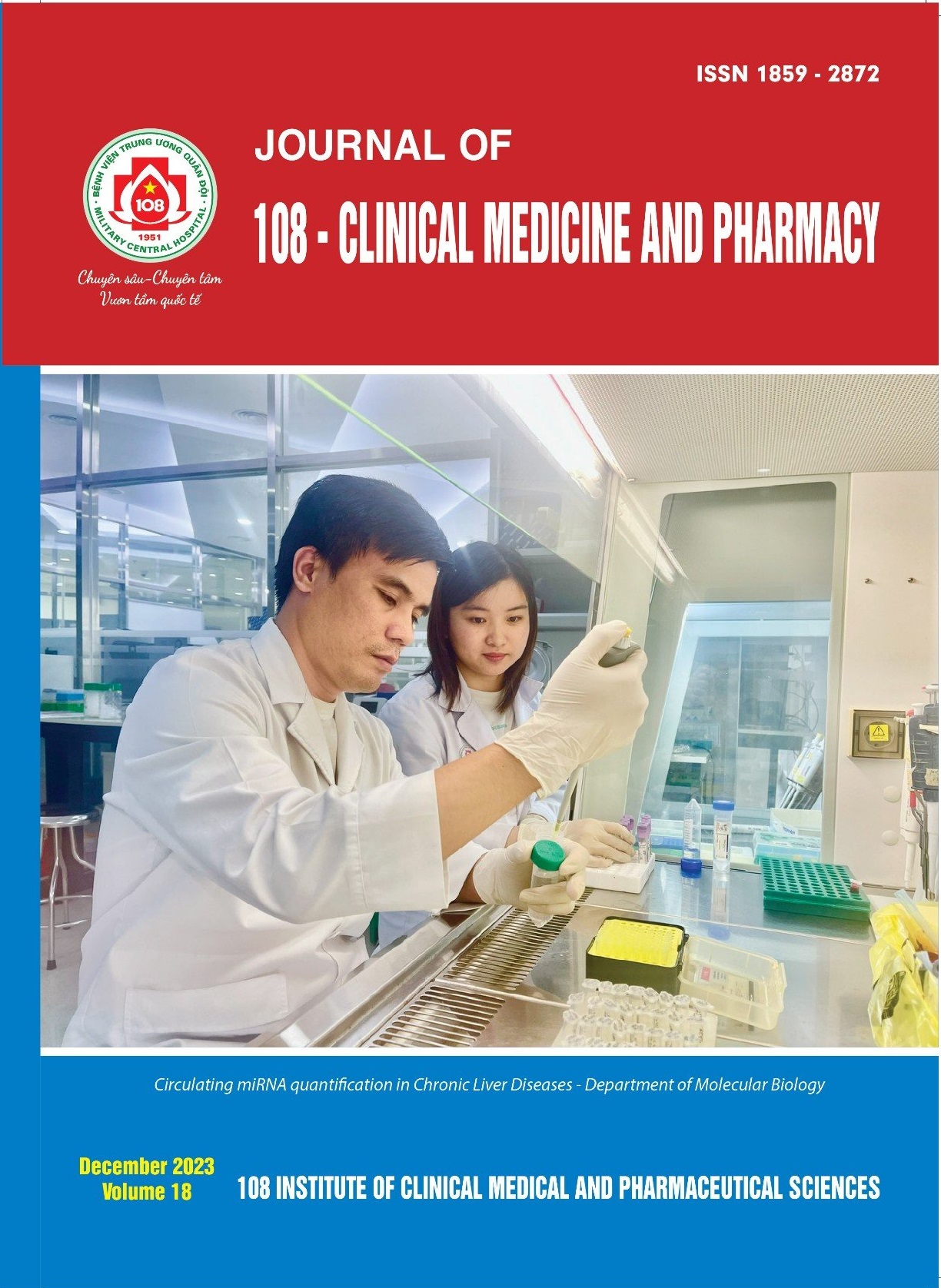The initial results of developmental dysplasia of the hip treatment by total hip arthroplasty
Main Article Content
Abstract
Objective: Comment on the initial results of developmental dysplasia of the hip treatment by total hip arthroplasty. Subject and method: This is a clinical descriptive study, with vertical follow-up and no control group study. 6 patients, including 5 females and 1 male, with developmental dysplasia including 6 hips were operated with total hip arthroplasty at the Joint Surgery Department of 108 Military Central Hospital from April 2018 to July 2022. The age range was 22 to 59 (average 39.1). The mean follow-up period was 37.5 months (ranged from 9 to 60 months). Result and conclusion: The average Harris score post-operation was 89.8 ± 7.1, significantly improved compared to 33.7 ± 4.7 pre-operation. 5/6 of cases used cement-less cup, 1 case used a compound of cement and liner polyethylene directly to the acetabulum. 1 case we had to perform proximal femur shortening. Three patients complained about limb length discrepancy. Two patients suffered temporary sciatic nerve paralysis post-operation.
Article Details
References
2. Bellamy N, Buchanan WW, Goldsmith CH et al (1988) Validation study of WOMAC: A health status instrument for measuring clinically important patient relevant outcomes to antirheumatic drug therapy in patients with osteoarthritis of the hip or knee. J. Rheumatol 12(15): 1833-1840.
3. Kosinski M (1997) Scoring the SF 12 physical and mental summary measures, Med. Outcomes trust. Bull 3(5).
4. Ovre S, Sandvik L, Madsen JE et al (2005) Comparison of distribution, agreement and correlation between the original and modified Merle d'Aubigne-Postel Score and the Harris Hip Score after acetabular fracture treatment: Moderate agreement, high ceiling effect and excellent correlation in 450 patients, Acta. Orthop 6(76): 796-802.
5. Gruen TA, McNeice GM, Amstutz HC (1979) Modes of failure” of cemented stemtype femoral components: A radiographic analysis of loosening, Clin. Orthop. Relat. Res 141: 17-27.
6. DeLee JG, Charnley J (1976) Radiological demarcation of cemented sockets in total hip replacement. Clin. Orthop. Relat. Res 121: 20-32.
7. Engh CA, Massin P, Suthers KE (1990) Roentgenographic assessment of the biologic fixation of porous-surfaced femoral components, Clin. Orthop. Relat. Res. 257: 107-128.
8. Sochart DH, Porter ML (1997) The long-term results of Charnley low-friction arthroplasty in young patients who have congenital dislocation, degenerative osteoarthrosis, or rheumatoid arthritis. J Bone Joint Surg Am 79: 1599-1617.
9. Numair J, Joshi AB, Murphy JC et al (1997) Total hip arthroplasty for congenital dysplasia or dislocation of the hip. Survivorship analysis and long-term results. J Bone Joint Surg Am 79: 1352-1360.
10. Lee BP, Cabanela ME, Wallrichs SL et al (1997) Bone-graft augmentation for acetabular defciencies in total hip arthroplasty. Results of long-term follow-up evaluation. J Arthroplasty 12: 503-510.
11. Kim M, Kadowaki T (2010) High long-term survival of bulk femoral head autograft for acetabular reconstruction in cementless THA for developmental hip dysplasia. Clin Orthop Relat Res 468: 1611-1620.
12. Klapach AS, Callaghan JJ, Miller KA et al (2005) Total hip arthroplasty with cement and without acetabular bone graft for severe hip dysplasia. A concise follow-up, at a minimum of twenty years, of a previous report. J Bone Joint Surg Am 87: 280-285.
13. Mortazavi SM, Restrepo C, Kim PJ, Parvizi J, Hozack WJ (2011) Cementless femoral reconstruction in patients with proximal femoral deformity. J Arthroplasty 26: 354-359.
 ISSN: 1859 - 2872
ISSN: 1859 - 2872
